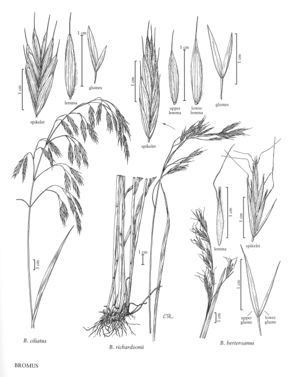Bromus richardsonii
Plants perennial; not rhizomatous. Culms 50-110 (145) cm, erect to spreading; nodes (3) 4-5 (6), usually glabrous, sometimes pubescent; internodes usually glabrous. Basal sheaths often retrorsely pilose; culm sheaths glabrous, often tufted-pilose near the auricle position, midrib of the culm leaves not abruptly narrowed just below the collar; auricles absent; ligules 0.4-2 mm, glabrous, rounded, erose, ciliolate; blades 10-35 cm long, 3-12 mm wide, flat, glabrous. Panicles 10-20 (25) cm, open, nodding; branches ascending to spreading or drooping, filiform. Spikelets 15-25 (40) mm, elliptic to lanceolate, terete to moderately laterally compressed, with (4) 6-10 (15) florets. Glumes usually glabrous, sometimes pubescent; lower glumes 7.5-12.5 mm, 1 (3) -veined; upper glumes 8.9-11.3 mm, 3-veined, often mucronate; lemmas 9-14 (16) mm, elliptic, rounded over the midvein, margins more or less densely pilose on the lower 1/2 or 3/4, lower lemmas in a spikelet glabrous across the backs, uppermost lemmas with appressed hairs on the backs, apices obtuse, entire; awns (2) 3-5 mm, straight, arising less than 1.5 mm below the lemma apices; anthers 1.6-2.7 mm. 2n = 28.
Discussion
Bromus richardsonii grows in meadows and open woods in the upper montane and subalpine zones, at 2000-4000 m in the southern Rocky Mountains, and at lower elevations northwards. Its range extends from southern Alaska to southern California and northern Baja California, Mexico; it is found as far east as Saskatchewan, South Dakota, and western Texas. Specimens with pubescent nodes and glumes are apparently confined to the southwestern United States.
Selected References
None.
Lower Taxa
"decumbent" is not a number.
